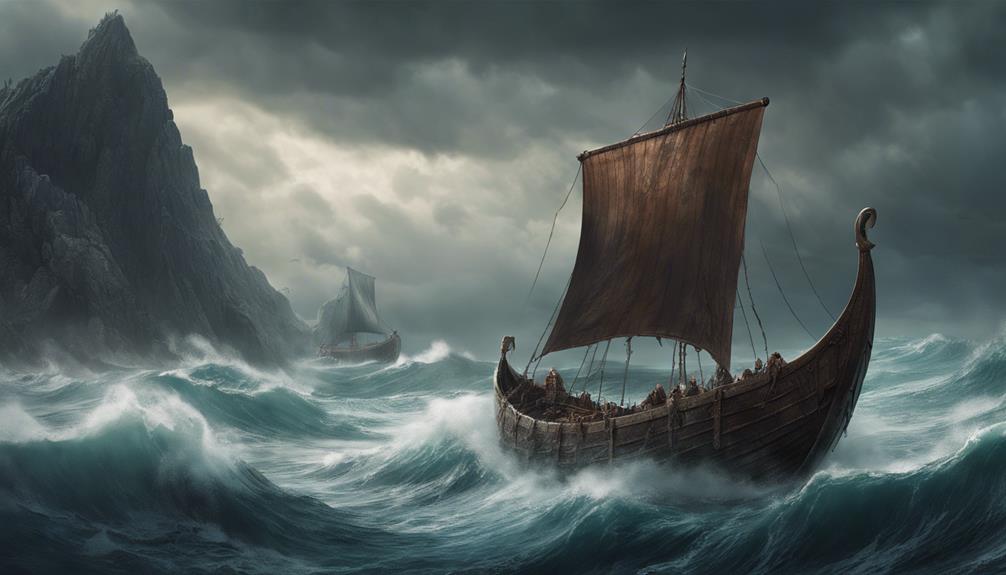The Vikings, a complex and intriguing civilization, have left an indelible mark on history through their multifaceted roles as explorers, traders, and conquerors. Originating from the Scandinavian regions of Denmark, Sweden, and Norway, these seafaring peoples ventured far beyond their homelands, reaching lands as distant as North America. Yet, the question remains: what drove these Norse warriors to embark on such perilous journeys, and what secrets do their travels hold about the extent of their influence on the world stage? Let us delve deeper into the enigmatic world of the Vikings and uncover the mysteries that lie within their remarkable exploits.
Key Takeaways
- Vikings were a structured society with three classes, including karls, jarls, and thralls.
- Viking raids and expansion targeted coastal regions, utilized hit-and-run tactics, and expanded reach through waterways.
- Viking settlements were established in Danelaw, Iceland, Greenland, and North America by notable figures like Erik the Red and Leif Eriksson.
- Viking influence spread through trade routes, establishment of trading towns, and impact on European military architecture and defenses.
Viking Origins and Culture
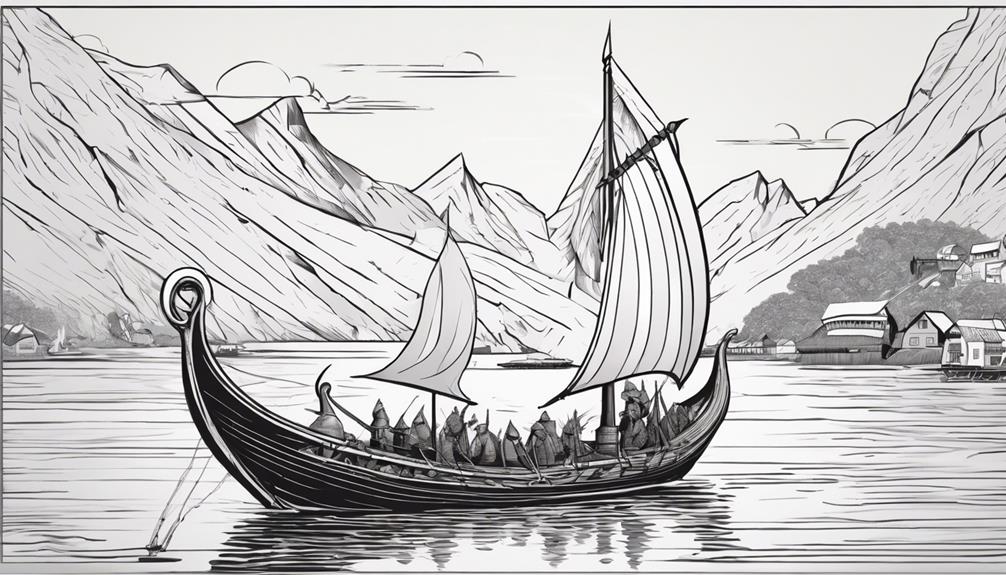
The exploration of Viking origins and culture reveals a structured society divided into distinct classes, where women held property rights and some even participated in combat as shieldmaidens. Viking society was stratified into three classes: karls, who were free farmers and traders; jarls, who were nobles and landowners; and thralls, who were slaves. This societal structure facilitated governance and resource distribution within the Viking communities. Women in Viking society enjoyed more rights than in many other contemporary societies, being able to inherit property and participate in trade and legal proceedings. The existence of shieldmaidens, women who took up arms in battle, challenges traditional gender roles of the time. This showcases a level of gender equality and individual agency within Viking culture that sets them apart from other civilizations of the North. Through exploration and conquest, the Vikings left a lasting impact on the regions they visited, spreading Norse mythology, sagas, and language, with evidence of their presence even reaching North America.
Early Viking Raids in Europe
Early Viking raids in Europe marked the beginning of a strategic and devastating campaign that targeted coastal regions for plunder and slaves, altering the dynamics of power and security in the affected territories. The Vikings, known for their hit-and-run raids, struck swiftly and expertly, causing chaos and fear among the local populations. Their raids were not limited to coastal areas but often penetrated deep inland, exploiting their knowledge of waterways to maximize their reach. The impact of these raids was far-reaching, prompting the creation of defensive structures and alliances to fend off future attacks.
- Viking raids in Europe began in the late 8th century, with notable attacks on monasteries like Lindisfarne in England.
- Coastal regions in Europe, including Ireland, Scotland, and France, were prime targets for the Vikings, who sought plunder and slaves.
- The Vikings' hit-and-run tactics involved quick strikes, looting, and capturing valuables before retreating to their ships.
- Their adept understanding of waterways enabled them to launch raids deep into inland territories, expanding the scope of their incursions.
Viking Expansion to England
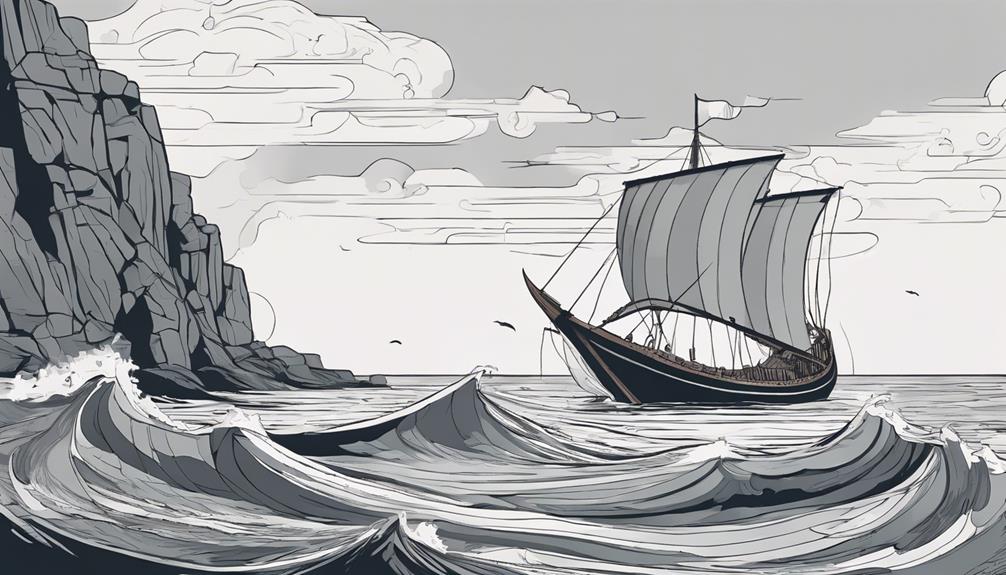
The Viking expansion into England, marked by the raid on Lindisfarne in 793 AD, set the stage for a series of invasions and conquests that would shape the region's history. The Great Heathen Army, led by the sons of Ragnar Lothbrok, played a significant role in subjugating large parts of England in the 9th century. King Alfred the Great's successful defense against Viking incursions and the establishment of the Danelaw exemplify the complex interactions between Vikings and Anglo-Saxons during this tumultuous period.
Viking Raids on England
Marking the late 8th century as a pivotal period, Viking raids on England initiated a series of incursions that transformed the landscape of the nation. The raids targeted significant locations such as Lindisfarne, setting the stage for further Viking activities on English soil. Notable events during this time included the invasion of the Great Heathen Army and the subsequent establishment of the Danelaw under the Treaty of Wedmore. The agreements between Alfred the Great and Viking leaders reshaped territorial boundaries and power dynamics in England, leading to a significant Viking presence in key areas like York (Jorvik). These incursions left a lasting imprint on English culture, language, and governance, as evidenced by historical records and archaeological findings.
Danelaw and Settlements
During the late 9th century, Viking settlers in England established the Danelaw, a region where they implemented their own laws and customs. Viking settlements within the Danelaw, such as York, Lincoln, and Nottingham, became prominent centers of Viking influence. The Danelaw came into existence following the conquests of the Great Heathen Army, marking a significant period of Viking expansion in England. Evidence of Viking presence in the Danelaw can be observed in place names, language variations, and archaeological discoveries. This era of Viking settlement not only altered the demographic landscape of England but also contributed to the cultural exchange between the Vikings and the Anglo-Saxons, leaving a lasting impact on the region's history.
Exploration of Iceland and Greenland
The Viking exploration of Iceland and Greenland marked significant milestones in their expansion across the North Atlantic. Iceland, settled by Ingólfur Arnarson in 874 AD, served as an early Viking colony, showcasing their ability to adapt to new environments. Greenland, colonized by Erik the Red in 985 AD, provided a strategic outpost for further exploration and trade routes in the region.
Viking Settlement in Iceland
In the late 9th century, Norse explorers initiated the establishment of Viking settlements in Iceland as part of their expansion into new territories. These settlements were crucial for Viking exploration and trade routes, offering a strategic base for further endeavors. Icelandic sagas such as the 'Landnámabók' provide valuable insights into the Viking exploration and colonization of Iceland, documenting the challenges and successes faced by these Norse settlers. The fertile land, abundant fish, and geothermal energy resources found in the Icelandic landscape supported the Vikings' settlement and survival, enabling them to establish farms, communities, and trading posts that played a significant role in shaping the early Icelandic society.
Leif Eriksson's Voyage
Leif Eriksson's pivotal voyage marked a significant chapter in Viking exploration, encompassing expeditions to Iceland and Greenland, ultimately leading to the first known Norse expedition to North America around the year 1000. Following in the footsteps of his father, Erik the Red, who established the first Norse settlement in Greenland, Leif Eriksson played a crucial role in expanding Viking presence across the North Atlantic. His exploration not only included visits to Iceland but also paved the way for subsequent Viking expeditions to North America led by figures like Thorvald and Thorfinn. The archaeological site of L'Anse aux Meadows stands as the only confirmed Norse settlement in North America, offering tangible evidence of the Vikings' remarkable journey to the New World.
Greenland Exploration Routes
By strategically navigating the North Atlantic from Iceland, Vikings efficiently explored Greenland, establishing vital settlements like Erik the Red's farmstead to support their expansion and colonization endeavors.
- Vikings explored Greenland by following the route from Iceland across the North Atlantic Ocean.
- They established settlements in Greenland, such as Erik the Red's farmstead, during their exploration.
- The Viking exploration routes to Greenland were crucial for their expansion and colonization efforts in the North Atlantic.
- Greenland served as a strategic outpost for Vikings to further explore and trade in the region.
Discovering Vinland in North America
One of the pivotal milestones in Viking exploration of North America was the discovery of Vinland by Leif Eriksson. This Norse explorer led the first known Viking expedition to the continent, establishing a connection between the Old World and the New World. Following Eriksson, another Viking explorer named Thorfinn Karlsefni, accompanied by his wife Gudrid Thorbjarnardottir, ventured to Vinland, further solidifying the Norse presence in the region. The archaeological site of L'Anse aux Meadows stands as the only confirmed Norse settlement in North America, providing tangible evidence of Viking exploration and activity in Vinland. Here, Vikings engaged in trade with Native American tribes, exchanging goods and resources. Despite these discoveries, debates among scholars persist regarding the exact locations of key places mentioned in Viking sagas, such as Straumfjord and Hop in Vinland, reflecting the ongoing quest to unravel the full extent of Viking exploration in North America.
Viking Invasions in Ireland and Scotland
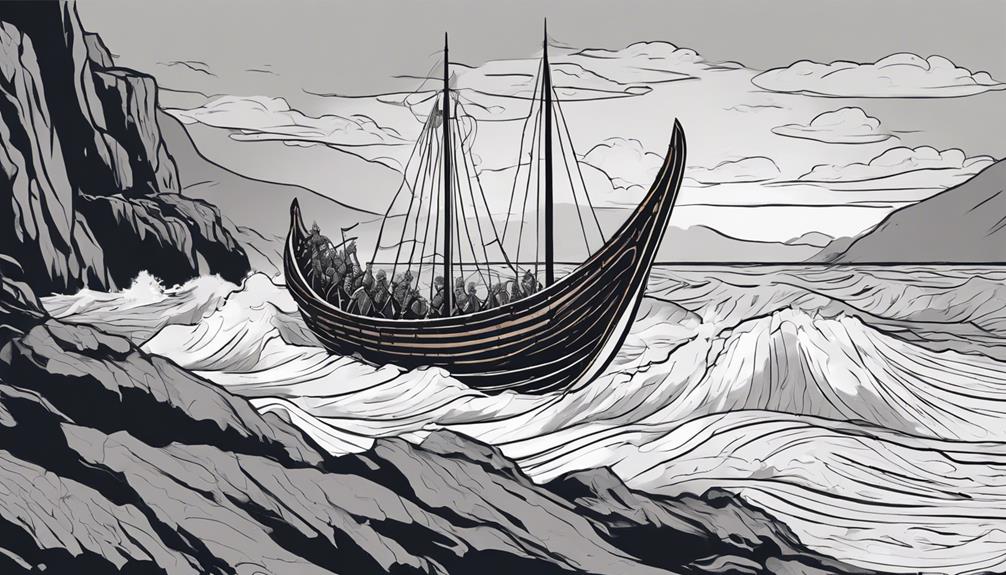
The Viking incursions into Ireland and Scotland during the 8th and 9th centuries were marked by strategic raids on monasteries and coastal regions, leading to the establishment of influential settlements and trading hubs in these territories. The Vikings left a lasting impact on both regions, shaping their political landscapes and cultural heritage. Key points to consider regarding the Viking invasions in Ireland and Scotland include:
- Targeted Locations: Viking invaders focused their attacks on monasteries and coastal areas in Ireland and Scotland to acquire wealth and resources.
- Establishment of Trading Towns: The Viking presence in Ireland resulted in the creation of trading towns like Dublin and Waterford, which became vital centers for commerce and cultural exchange.
- Influential Viking Rulers: Figures such as Ivar the Boneless and Olaf the White played significant roles in Irish and Scottish politics, influencing the dynamics of power in the region.
- Clash of Cultures: The Battle of Clontarf in 1014 exemplified the ongoing conflict between Irish forces and Viking invaders, culminating in a decisive victory for the Irish led by Brian Boru.
Norse Settlements in France and Spain
Viking expansion into France and Spain led to the establishment of significant Norse settlements in these regions, shaping the socio-political landscape and cultural fabric of the territories. In France, the Viking presence is notably represented by the establishment of Normandy. After being granted land in 911, the Viking leader Rollo founded this region, which later evolved into a crucial Viking stronghold that eventually integrated with Frankish culture. On the other hand, in Spain, Vikings conducted raids primarily in the 9th century, targeting regions like Galicia and Asturias. Their raids focused on plundering monasteries and coastal areas for resources. The lasting impact of Viking influence in France and Spain is evident in the cultural, linguistic, and traditional aspects of these regions. The amalgamation of Viking heritage with the local cultures of France and Spain showcases the intricate interplay between different civilizations during this historical period.
Trade Routes in the Baltic Sea
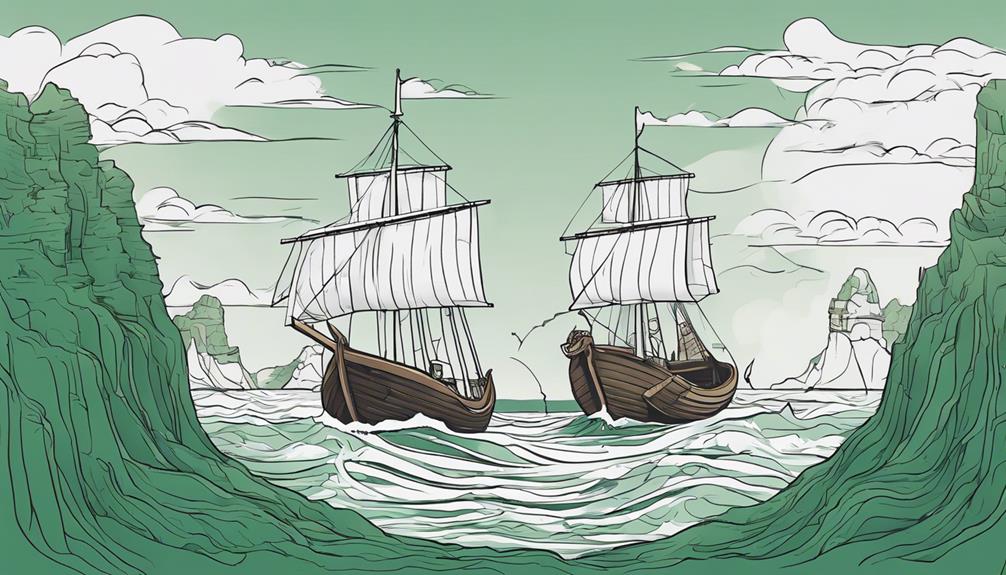
Establishing crucial maritime pathways, the trade routes in the Baltic Sea played a pivotal role in fostering economic interactions among regions spanning Scandinavia, Russia, and the Baltic countries. The Vikings utilized these trade routes extensively, leveraging the Baltic Sea as a key maritime highway for their expeditions and exploration. The exchange of goods such as amber, furs, timber, iron, and slaves flourished along these routes, enhancing economic activities and cultural exchanges. This trade network allowed the Vikings to engage with diverse cultures, expand their economic influence, and solidify their presence in the region. The Baltic Sea trade routes were integral to the Viking economy, supporting their exploration endeavors and contributing significantly to their overall expansion across different territories.
- The trade routes in the Baltic Sea connected regions like Scandinavia, Russia, and the Baltic countries.
- Goods such as amber, furs, timber, iron, and slaves were exchanged along these routes.
- The Vikings heavily relied on the Baltic Sea as a maritime highway for trade and exploration.
- The Baltic Sea trade routes facilitated cultural exchanges, economic growth, and Viking expansion.
Legacy of the Viking Age
Following their decline in influence post-1066, the lasting impact of the Viking Age on European history manifests in the legacy of cultural exchange, technological advancements, and societal transformations. The Viking legacy is evident in the fortifications and defense systems constructed in response to Viking raids, which influenced European military architecture. The cultural identity introduced by the Vikings gradually waned as European nations developed stronger defenses against further invasions. The end of the Viking Age, epitomized by events like the Battle of Stamford Bridge in 1066, marked a significant shift in European dynamics. Viking warriors, once feared for their fierce raids, became integrated into European societies through trade and settlements, leaving a lasting imprint on language, art, and governance. European resistance and internal conflicts within Viking communities played a crucial role in diminishing Viking influence by the 11th century. The decline of the Vikings paved the way for the emergence of new powers and alliances, shaping the course of European history.
Frequently Asked Questions
Who Were the Vikings and Where Did They Travel?
In exploring Viking culture, it is essential to delve into their seafaring prowess, expansionist mindset, and impact on trade networks. The Vikings' exploration routes spanned across regions like England, Ireland, Scotland, Iceland, Greenland, and North America, leaving behind evidence of their presence. Their voyages not only facilitated trade but also disseminated Norse mythology and sagas, contributing to a cultural exchange that shaped European languages and genetic diversity.
Who Were the Vikings and Where Did They Explore and Settle?
Viking exploration encompassed vast territories, with notable settlements in Greenland, trade routes reaching the Middle East, conquests in England, and even voyages to North America. Their strategic colonization efforts reshaped the cultural, linguistic, and genetic landscapes of these regions, leaving a lasting imprint on history. Through archaeological evidence and historical records, the extent of Viking exploration and settlement highlights their profound impact on diverse regions across the globe.
Who Are Vikings in History?
In history, Vikings were a prominent group characterized by their distinct culture, fierce warriors, advanced ship technology, and rich Norse mythology. Their society was structured with classes like karls, jarls, and thralls, where women had property rights and some even fought as shieldmaidens. The term 'Viking' originated from the Old Norse word 'vikingr,' denoting their seafaring and raiding nature. Their legacy is deeply intertwined with their exploration, trade, and impact on European history.
Where Did the Vikings Raid and Explore?
The Vikings, known for their daring expeditions, established settlements along strategic trade routes, expanding through raiding strategies and conquests. Their exploration routes led to significant discoveries in regions like England, Ireland, Scotland, Iceland, Greenland, and North America. Cultural interactions with diverse societies influenced Norse mythology and sagas. These interactions left a lasting impact on languages, cultures, and genetic makeup, shaping modern-day societies and place names.
Conclusion
In conclusion, the Vikings were a complex and influential group of explorers, traders, and raiders who left a lasting impact on European history. Like a powerful tide reshaping the shore, the Vikings expanded their influence through exploration and settlement, leaving traces of their culture, language, and genetic heritage across the lands they touched. Their legacy continues to be felt in modern society, reminding us of the dynamic and ever-evolving nature of human civilization.
